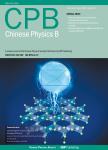Three-dimensional size and orientation of the precipitates in AZ91 magnesium alloys measured by TEM techniques
Three-dimensional size and orientation of the precipitates in AZ91 magnesium alloys measured by TEM techniques作者机构:Department of Physics and Key Laboratory of Acoustic and Photonic Materials and Devices of Ministry of Education Wuhan University Centre for Electron Microscopy Wuhan University
出 版 物:《Chinese Physics B》 (中国物理B(英文版))
年 卷 期:2009年第18卷第10期
页 面:4370-4379页
核心收录:
学科分类:082304[工学-载运工具运用工程] 08[工学] 080204[工学-车辆工程] 080502[工学-材料学] 0805[工学-材料科学与工程(可授工学、理学学位)] 0802[工学-机械工程] 0823[工学-交通运输工程]
基 金:Project supported by the National Natural Science Foundation of China (Grant Nos 50571075 and 50771074) the Program for New Century Excellent Talents in University, China (Grant No NCET-07-0640)
主 题:transmission electron microscopy microstructure Mg electron energy loss spectroscopy
摘 要:Knowledge of the microscopic structure, including three-dimensional (3-D) size and orientation of the precipitates, is essential to fully understand the mechanical properties of the magnesium alloys and designing the alloys with better performance. Analytical TEM with high spatial resolution offers the simultaneous measurements of 3-D size, structure, orientation, composition of the precipitates from one typical sample along an established crystallographic axis. Besides popular Burgers orientation relationship (OR), other ORs such as Pitsch-Schrader OR, Crawley OR, Potter OR and a new OR with the form of [0001]α 1.0° from [311]γ and (1120)α 2.0° from (033)γ between the magnesium matrix and the precipitate γ-MglTAl 12 are identified by TEM imaging and diffraction techniques. As a case study, the thicknesses of the individual precipitates with Burgers OR are further measured to be 100 200 nm through both electron energy-loss spectroscopy and x-ray energy dispersive spectroscopy combining differential x-ray absorption and extrapolation, which are in agreement with the overall 3-D size statistic distribution results obtained through analysing various samples along various directions. Furthermore, the fabricated wedge-shape structure provides a platform on which to study the dependence of the interfacial strain on the variation of the thickness.



